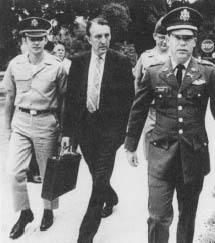William Calley Court-Martial: 1970
Some Refused Orders
Defendant: William L. Calley
Crime Charged: Murder
Chief Defense Lawyers: Brookes S. Doyle, Jr., Richard B. Kay, George W. Latimer, and Kenneth A. Raby
Chief Prosecutors: Aubrey Daniel and John Partin
Judge: Reid W. Kennedy
Place: Fort Benning, Georgia
Dates of Court-Martial: November 17, 1970-March 29, 1971
Verdict: Guilty
Sentence: Life imprisonment
SIGNIFICANCE: The trial of Lt. William Calley for war crimes is unique in American military history. It provides a unique insight into the horrors of combat and the reaction of ordinary people to extraordinary circumstances.
At first light on the morning of March 16, 1968, 105 soldiers of Charlie Company, a unit of the U.S. 11th Light Infantry Brigade, moved unopposed into the Vietnamese hamlet of My Lai. By midday almost 500 inhabitants had been massacred. All of the victims were unarmed civilians, women, babies, and elderly men. By chance, the scenes of carnage were recorded by an Army cameraman, and it was his pictures that revealed the horror of My Lai to the world. An Army inquiry into the incident resulted in charges of murder against several participants, but evidence suggested that the majority of blame for the tragedy could be laid at the door of a single platoon commander: Lieutenant William Calley.
When the court-martial began on November 17, 1970, Calley was charged with murdering 109 "Oriental human beings." It was the prosecution's contention that Calley, in defiance of U.S. Military Rules of Engagement, ordered his men to deliberately murder innocent civilians. In presenting his case, lead military prosecutor Aubrey Daniel was hamstrung by the reluctance of many soldiers to testify against Calley. Some refused point-blank, citing the Fifth Amendment privilege against self-incrimination. Perhaps the strangest of the holdouts was Paul Meadlo. It had been his televised interview, coupled with Ronald Haeberle's photographs, that had largely inflamed public opinion about My Lai. Yet only after having been ordered into custody by Judge Reid Kennedy, who scathingly derided "the nauseous detail" that Meadlo had provided for television, and being granted immunity from prosecution, would Meadlo describe that day's tragic events. He told of standing guard over dozens of villagers when Lieutenant Calley arrived. "He said 'How come they're not dead?' I said, 'I didn't know we were supposed to kill them.' He said, 'I want them dead.' He backed off twenty or thirty feet and started shooting into the people." Meadlo joined him.
"Were you crying?" asked Daniel.
"I imagine I was," replied Meadlo, confirming other testimony that had the enlisted man with tears in his eyes and a rifle in his hands. Between them, Calley and Meadlo mowed down a hundred villagers.
Barbarous Action Described
Piece by agonizing piece, Daniel painted an almost unimaginable picture of murder, rape, and wholesale devastation. He described how Calley tossed a baby into a ditch and shot it, before opening fire with an M-16, first killing a monk, then cutting a swathe through dozens of villagers cowering in an irrigation channel.
 William Calley arriving at court.
William Calley arriving at court.
An eyewitness, Dennis Conti, described the bloodbath:
They were pretty much messed-up. There was a lot of heads had been shot off, pieces of head … fleshy parts of the body.… I seen the recoil of the rifle and the muzzle flashes and as I looked down, I seen a woman try to get up. As she got up I saw Lt. Calley fire and hit the side of her head and blow the side of her head off.
The madness was infectious. One man who had refused to participate in the slaughter, Leonard Gonzalez, told of seeing another soldier herd some women together and order them to strip. When they refused to have sex with him, the enraged soldier fired a single round from his grenade launcher into the group, killing everyone.
Originally it was the defense position that the devastation of My Lai had been caused by helicopters and aerial bombardment. Clearly the prosecution witnesses had proven that premise to be untrue. Calley's only recourse was to fall back on the defense of soldiers since time immemorial: that he was merely acting on orders.
Under the prompting of civilian attorney George Latimer, Calley told his side of the story. He outlined a briefing given one day before the operation by his commanding officer, Captain Ernest Medina, at which, he said, it was made plain that everyone in the village was to be shot. Twenty-one other members of Charlie Company present at the briefing corroborated Calley's story; others denied that any such order was given. Yet more testified that, while unstated, the intent of the order was plain.
Calley: I was ordered to go in there and destroy the enemy. That was my job that day. That was the mission I was given. I did not sit down and think in terms of men, women, and children. They were all classified the same, and that was the classification that we dealt with, just as enemy.… I felt then and I still do that I acted as I was directed, and I carried out the orders that I was given and I do not feel wrong in doing so.
Additional topics
- Wisconsin v. Yoder - Significance, The Amish And Schooling, Further Readings
- The Whitmore Confessions and Richard Robles Trial: 1965 - Confessions Discredited, Richard Robles Arrested, Whitmore Retried In Assault Case, Whitmore Convicted Again, Then Released
- William Calley Court-Martial: 1970 - Some Refused Orders
- Other Free Encyclopedias
Law Library - American Law and Legal InformationNotable Trials and Court Cases - 1963 to 1972